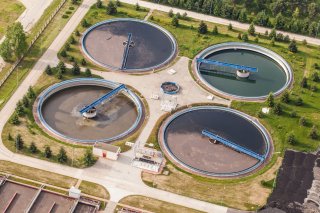Wastewater Research
- Developing Methods to Monitor Chemical Risks in Wastewater
- Monitoring Wastewater to Inform Public Health and Environmental Decision-Making
- Evaluating and Mitigating Contaminants of Emerging Concern
- Related Research and Resources

Wastewater Water that has been used in homes, industries and businesses that is not reusable unless treated by a wastewater facility. management is a critical part of the anthropogenic Induced by humans. water cycle that helps ensure that water is clean, safe to use, and protective of ecosystems. There are challenges to effectively managing wastewater systems, such as wet weather runoff that flows from urban communities into wastewater collection systems. Further, runoff from unpredictable storms or continuous heavy rain events can result in rapid changes to flow rates and volumes of wastewater that must be collected and treated. These rates can exceed the design structure of treatment processes at the utility, such as pipe systems, resulting in sewer overflows.
EPA's wastewater research includes the development of tools and methods to address known contaminants in wastewater and identify risks to human health and the environment.
Developing Methods to Monitor Chemical Risks in Wastewater
Effects-based methods are used to detect known and unknown chemical contaminants in wastewater and reclaimed water. These assays can be used to rapidly and selectively screen waters for possible harmful physiological effects. EPA researchers are working to develop these effects-based methods and to apply bioassay data for use in managing and controlling contaminants.
Research Focus
- Standardizing methods for use in the Whole Effluent and Receiving Water Toxicity Testing Program.
- Developing cell-based assays for assessing known and unknown chemical contaminants in wastewater.
- Integrating non-targeted chemical methods and transcriptional effects-based bioassays for the characterization of wastewater discharge.
Monitoring Wastewater for Inform Public Health and Environmental Decision-Making
Since wastewater is a collection of human solids and used water from a community, it can be good source for identifying targets that determine community health. Optimizing wastewater monitoring for public health requires identifying and prioritizing markers of concern, such as coronavirus, antimicrobial resistance (AMR), other public health-relevant microbial or chemical markers for human health. EPA researchers are developing standardized analytical methods for identifying and measuring targets and designing sampling plans within sewer networks and at local, state, and national scales. Understanding the fate and transport (where contaminants go and how they get there) in collection and treatment systems is important to inform early warning for disease incidence. Monitoring these systems can signal the prevalence of contaminants within the community and the risks related to environmental releases.
Research Focus
- Monitoring public health relevant microbial or chemical contaminants in wastewater to inform early warning of disease incidence and prevalence within the community.
- Assessing antimicrobial resistant bacteria in wastewater collection systems and their removal during treatment, and related risks of environmental releases.
Evaluating and Mitigating Contaminants of Emerging Concern
EPA researchers are assessing environmental effects on the detection, evaluation, and treatment of chemical and microbial contaminants in wastewater and biosolids systems. These contaminants include a wide range of pathogenic microbes, including bacteria, viruses and protozoans, and chemicals, such as household chemicals, pharmaceuticals, personal care products, and natural toxins.
Research Focus
- Analyzing existing wastewater treatment and septic systems for managing contaminants.
- Assessing the impacts of biosolids, wastewater residuals, and other high strength organic wastes to protect public and ecosystem health.
- Advancing wastewater infrastructure technologies and management for small utilities.
Related Research and Resources
Research
- Wastewater Research Publications in Science Inventory
- Wastewater Contaminants Research
- Alternative Wastewater Disinfectant Research
- Alternative Water Sources Research
- Stormwater Management
- Enhanced Aquifer Recharge
- EPA information on Municipal Wastewater
- EPA information on Industrial Wastewater
Models and Tools
- EPA Science Models and Research Tools (SMaRT) Search
- Environmental Technologies Design Option Tool (ETDOT)
- Non-potable Environmental and economic Water Reuse calculator (NEWR)
- PFAS Analytical Methods Development and Sampling Research
- Water Modeling Tools for Decision Support
- Method 1622: Cryptosporidium in Water by Filtration/IMS/FA (2005)
- Method 1623: Giardia Report Form (pdf)
- Method 1622/1623 Spiking Suspension Enumeration Form: Cryptosporidium Giardia (pdf)
- Hemacytometer Data Sheet for Cryptosporidium Giardia (Circle One), July 1998 (pdf)
